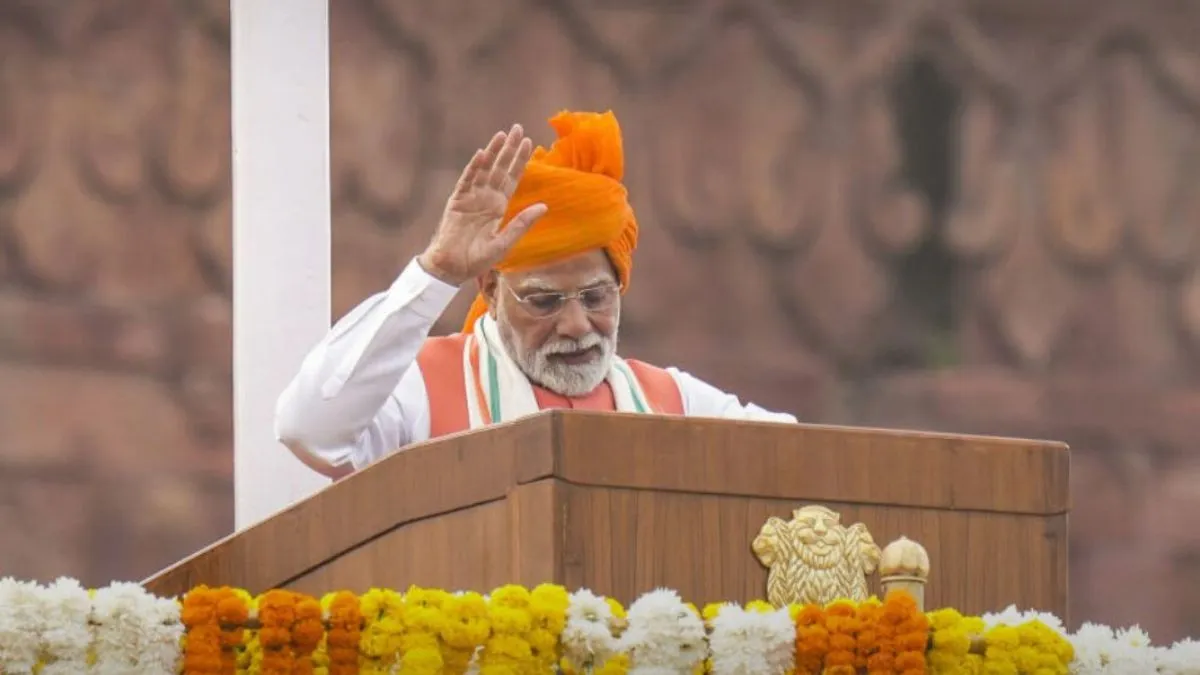- By Supratik Das
- Fri, 15 Aug 2025 11:17 AM (IST)
- Source:JND
Independence Day 2025: Prime Minister Narendra Modi Friday, stated that the country's first semiconductor chip will be launched in the market by the end of the current year, a historic step for India's technology manufacturing industry. Addressing the nation from the ramparts of the Red Fort on the 79th Independence Day, the Prime Minister informed that six semiconductor factories are already in operation, and four new factories recently received clearance from the Union Cabinet.
He emphasised that this has been a long-awaited journey, as India's chip vision was initially thought out close to six decades back but got "stuck in files" as others progressed. “By the end of this year, made in India, made by the people of India, chips will come to the market,” PM Modi said, observing that the nation has now shaken off the baggage of the past and is making progress in mission mode.
#WATCH | PM Narendra Modi says, "...We are working on semiconductors on Mission Mode...By the end of this year, Made in India semiconductor chips, made by the people in India, will hit the market."
— ANI (@ANI) August 15, 2025
Video: DD pic.twitter.com/SM5oTOhjAO
India's Semiconductor Push Gathers Momentum
The semiconductor sector, a pillar of contemporary electronics, drives everything from smartphones, laptops, and domestic appliances to electric cars, defence equipment, and artificial intelligence technologies. Industry estimates indicate India's semiconductor market, which was USD 38 billion in 2023, has already reached USD 45-50 billion in 2024-25 and will grow to USD 100-110 billion by 2030.
The recent approval by the Union Cabinet of four large semiconductor projects totaling Rs 4,594 crore is expected to further speed up India's growth in this high-value industry. They include:
• 3D Glass Semiconductor Packaging Unit of 3D Glass Solutions Inc, supported by Intel, Lockheed Martin, and Applied Materials, with an investment of Rs 1,943 crore and a capacity of 5 crore units every year.
• SiCsem's Compound Fabrication Unit in Bhubaneswar, for silicon carbide chips, at an investment of Rs 2,066 crore with a capacity of 9.6 crore chips per annum.
• Advanced System in Package Technologies' Chip Packaging Plant in Andhra Pradesh, with a capacity of 9.6 crore chips per year.
• Punjab-based CDIL's Semiconductor Unit, with a capacity of 15.8 crore units annually.
With these approvals, India has 10 semiconductor factories in the pipeline, supported by a cumulative investment commitment of Rs 1.6 lakh crore.
#WATCH | PM Narendra Modi says, "When we speak of different aspects of technology, I draw your attention to semiconductors, as an example. I am not at the Red Fort to criticise any government; I do not want to do it. But the youth of the country should know about it. File work on… pic.twitter.com/Kvzf1Ml6NB
— ANI (@ANI) August 15, 2025
India Among The Global Top 10 Semiconductor Countries
India has joined global champions like Taiwan, the United States, South Korea, China, Japan, the Netherlands, Germany, Singapore, and Israel in the league of the Top 10 Semiconductor Countries in 2025.
Global Semiconductor Leaders In 2025
1. Taiwan – Dominates high-end chip manufacturing with TSMC and UMC.
2. United States – Dominant in chip design, AI processors, and semiconductor equipment.
3. South Korea – Global leader in DRAM and NAND flash memory fabrication.
4. China – Biggest consumer and fast-growing domestic production.
5. Japan – Leader in semiconductor materials and precision equipment.
6. Netherlands – Site of ASML, the world's only supplier of EUV lithography machines.
7. Germany – Expertise in automotive and industrial semiconductors.
8. Singapore – Leading Southeast Asian chip fabrication and packaging hub.
9. Israel – Pacesetting fabless design of chips and AI processor innovation.
10. India – Steadily expanding in design, testing, packaging, and now moving into chip fabrication.
Long-Delayed Dream Turning Into Reality
PM Modi recalled that the first known effort to establish a semiconductor factory in India was initiated by Robert Noyce, Intel's co-founder, in the late 1960s, but never took off. "The thinking for semiconductors in India was foeticide 50-60 years back. We lost decades, but today we are catching up with lost time," PM Modi said. By a judicious combination of policy interventions, international collaborations, and domestic innovation, India can sharply bring down its dependence on imports in semiconductors, which is at an over 90 per cent level now, and become a world hub for chip production and design by the coming decade.
With the India Semiconductor Mission going in high gear, fueled by billions of government subsidies and strategic partnerships with industry giants like Intel, Foxconn, and Micron, India is not just getting set to debut its first indigenous chip this year, but also looking to make a steady presence in the global semiconductor value chain. The entry of the first Made-in-India semiconductor chip into the market will be a watershed moment in India's technology journey, one that could reshape India's place in the global digital economy for generations ahead.

